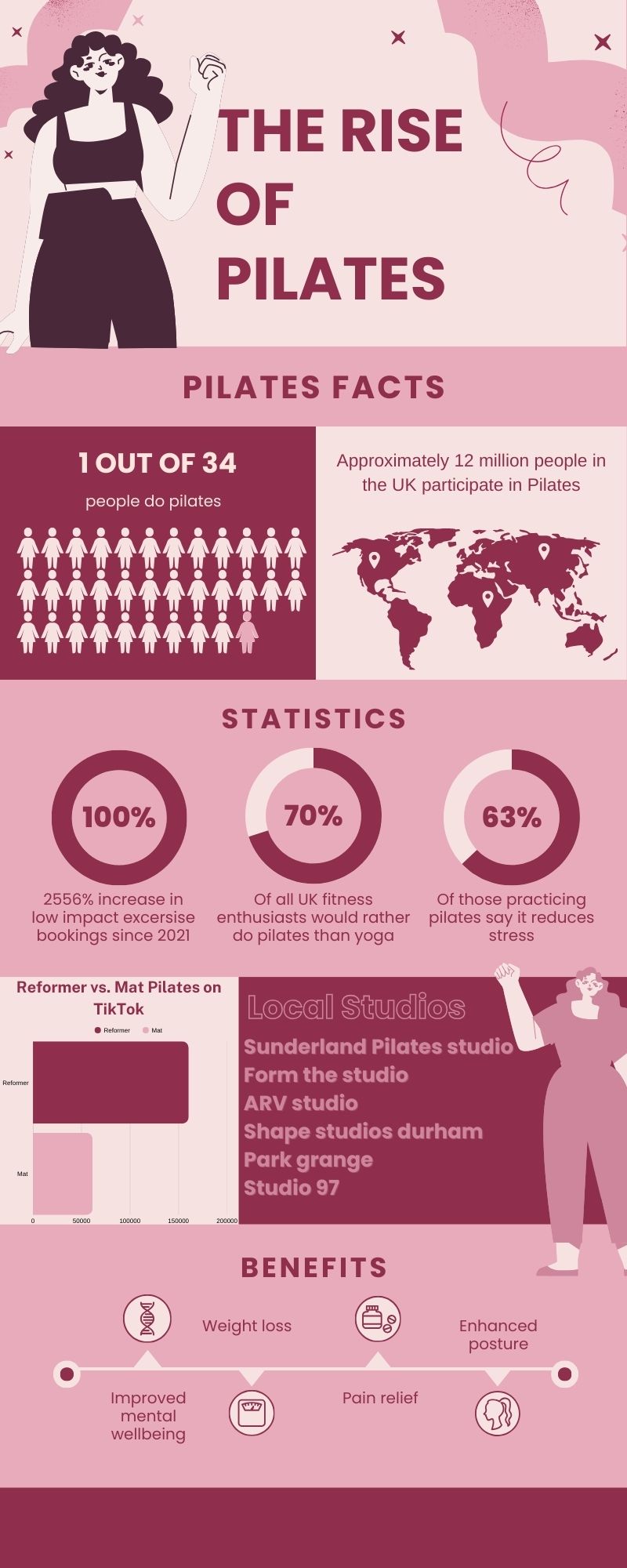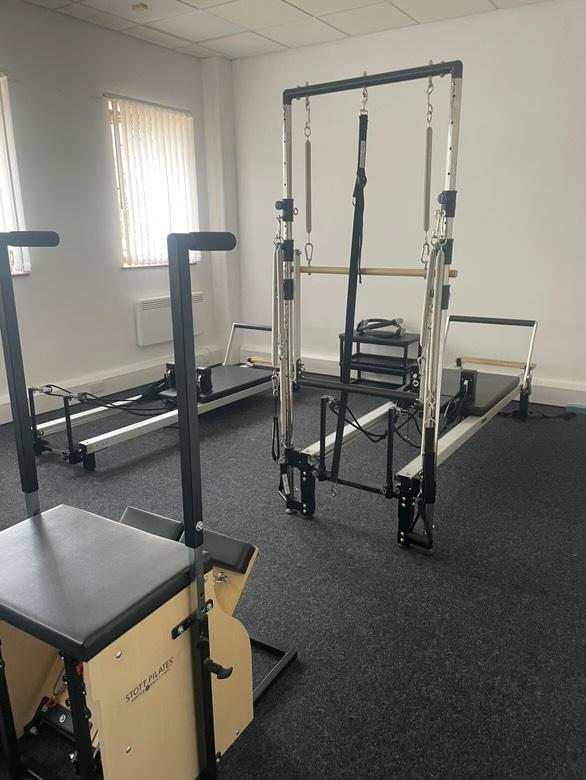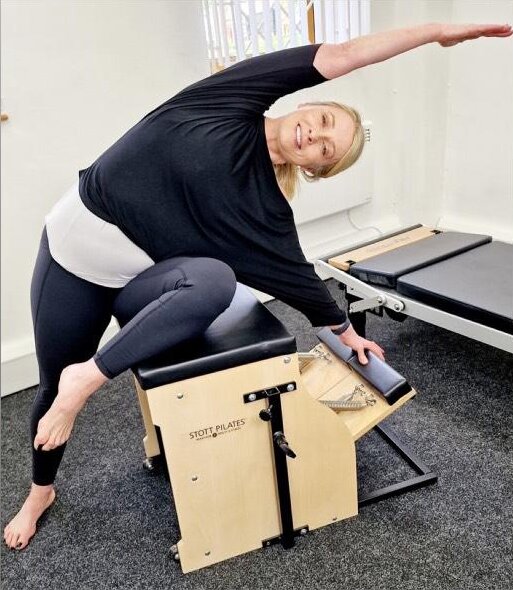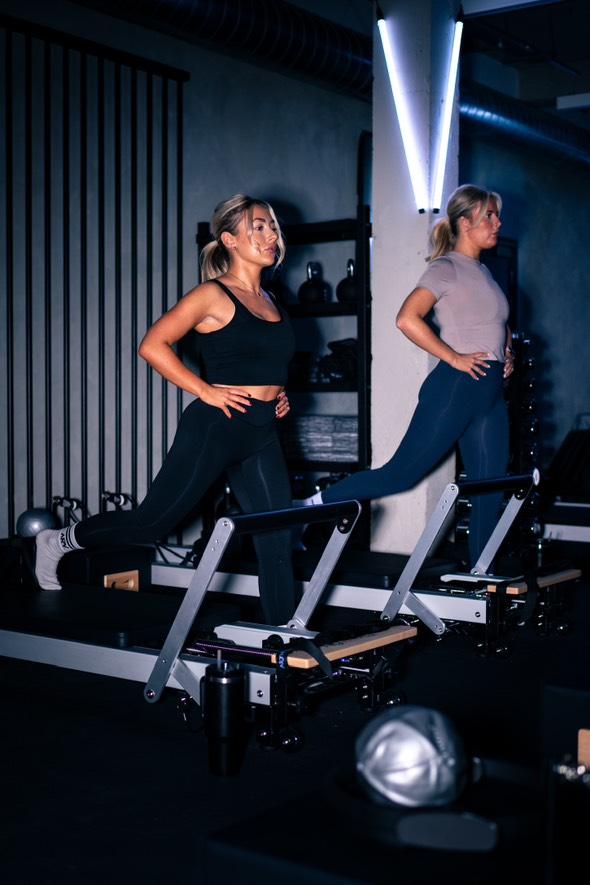
Shuffle Collage made by Maia Olusanya
Is this social media aesthetic creating impossible standards in the fitness world or bringing an extremely beneficial practice into the spotlight?
Picture this, you’re lying in your bed doomscrolling when a brightly lit perfectly shot video appears on your explore page, and there she is in all her glory. Head to toe in pastel Lycra wearing a bubblegum pink lululemon jacket, crisp white Alo socks and neatly slicked back hair held back with an adorable headband that you can never seem to style quite right, but she seems to have mastered. Donning unreasonably expensive headphones and talking softly like she’s letting you in on the secrets of the universe. Pristine, beautiful, unattainable. The Pilates princess. This article will explore how the Pilates princess trend has affected the fitness world, whether it is creating false expectations and impossible standards or encouraging people to try new ways to stay fit.
According to Gymcatch they saw a 2556% increase in low impact exercise booking in 2021 and a 25% increase in Pilates between 2020 and 2021 and that up to 12 million people in were known to be participating and enjoying Pilates just during covid alone, setting it up to take the crown as a huge fitness trend even beating yoga. “We have seen a surge for low impact classes. People are increasingly focused on wellness and Pilates offers a great blend of flexibility and strength training,” says Ollie Bailey, CEO at Gymcatch. On TikTok alone the Pilates tag boasts 1.5 million posts, and the Pilates princess tag has 84.5k.

Canva Pilates Infographic made by Maia Olusanya
This rise of Pilates, however, has seen a lot of people rushing into becoming certified and not going through the proper 300 hours of teaching practice, and of learning both anatomy and physiology. Janet Whitwood a 3rd generation Pilates instructor and owner of Sunderland Pilates Studio said “instead of doing fully comprehensive courses, which is very time consuming and very expensive, training organisations have been able to just learn reformer. There are no regulations either. So basically, anyone could go and do an online course and just be able to teach reformer.”

Reformer machine at Sunderland Pilates Studios. Pic Credit: Janet Whitwood

Reformer machines at ARV studios. Pic Credit: Maia Olusanya
Another issue as much as social media through the ‘Pilates Princess’ has made Pilates more accessible the message of what it really is has been misconstrued and the core values of the practice are no longer being taken into account. Janet stated “I think it’s got two sides to it because I’m so happy that the Pilates word has got out there but then on the other side of it, it’s all reformer, I see a lot on Instagram and none of the Pilates principles are applied to any of the movements. It’s more like fitness on a reformer, you know, So that’s the bad side of it. The scary thing is if somebody is new to Pilates they think that’s what Pilates is, and it isn’t.” Reformer Pilates has over double the posts mat Pilates has under their respective tags. However some argue that the new and different ways of doing Pilates aren’t a bad thing, Founder of the very trendy ARV studios stated “I’m not from the Pilates world and I’m not afraid to push the boundaries, I know a lot about training and exercise and all different types of principles of exercises but I’m not stuck in the Pilates bubble and I’m not afraid to take a much more modern approach… I’m happy to kind of expand out.”

Janet Whitwood of Sunderland Pilates studios. Pic Credit: Janet Whitwood
When it comes to the look conveyed by the “Pilates princess” it’s certainly setting some crazy standards for women looking to try it out, this polished image circulating online of the perfect women could be scaring people off. Regarding this Whitwood stated “On Instagram, social media, the way that they’re sort of depicted is an issue… I mean, it’s hard for someone to even come in a studio for the first time, I don’t want them to feel worried about what they look like do they look right or are they strong enough. I think a good student and a good teacher should like to show real people and show that everybody is welcome and accepted. I definitely think there’s an issue there.” Fitness influencer and Pilates instructor Carla Casty said “Pilates is often marketed as a fitness routine that will make you “slim” “toned” “lean” which is simply not the case…Pilates has amazing benefits that are often overshadowed by the misleading marketing of the body that Pilates provides….this is not the beginning of fitness trends being associated with fashion/political/body image trends for women and is certainly not the end.”

A Pilates Class at ARV studios in Sunderland. Pic credit: ARV studios
ARV also studios talk about why they think people especially women are now turning to low impact exercise. She states “I think because it’s a slightly softer approach to exercise, and women have often felt that like fitness or fitness spaces are a little bit intimidating. I used to be a PT for a long time for women before doing this, and I found that women did struggle with the gym. I think that’s probably why Pilates is growing because it’s quite a female dominated environment. It’s a softer type of exercise. It’s not as high intensity”. The facts definitely back this up as Clearinghouse for sport’s statistics show that 90% of Pilates participants are women.
Although this aesthetic has a lot of downsides such as promoting unhealthy body standards and leaning away from core Pilates values, I think it’s clear that Pilates is here to stay, Janet stated “I think it’s just going to get bigger” referring to the Pilates princess trend. Many would argue this new trend is just a bit of fun, Content creator Carla said “As a creative person I admire the feminization of hobbies and love people expressing themselves…the Pilates princess trend is so cute and fun. I hope people take away from this that although trends are fun and it’s fun to express yourself, be your authentic self always.”
